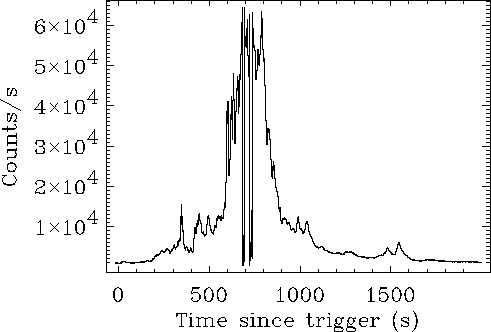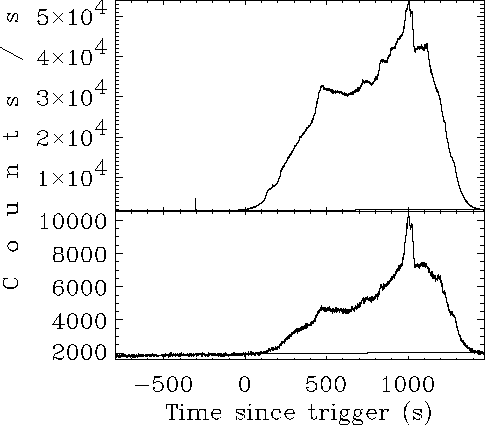



Next: Conclusions
Up: Solar Hard X-Ray Flares
Previous: Solar Hard X-Ray Flares
Contents
Several of the GRB candidates (174) found with our systematic
GRB search have been classified as solar flares.
In fact, these 174 solar flares automatically detected
do not correspond to distinct flares: for the longest
flares, more than one trigger occurred in the GRB quest;
after visual inspection, it has come out
that these 174 off-line triggers refer to 146 distinct
flares occurred during the scanned interval (July 1996 -
October 2001).
In order to determine whether a transient event could
have come from the Sun, cross-checks with the NASA mission
GOES have been performed: the 146 distinct flares have
been identified as solar flares thanks to the simultaneous
GOES detections, performed in the 1-8 Å energy range.
On the other hand, since they triggered the HR condition
(eq. ![[*]](crossref.png) ),
it means that this set of solar flares
collects the hardest ones, among those that could be
detected with the GRBM.
Due to this, all the X-ray solar flares that have been
observed in the only 40-700 keV and not in the
),
it means that this set of solar flares
collects the hardest ones, among those that could be
detected with the GRBM.
Due to this, all the X-ray solar flares that have been
observed in the only 40-700 keV and not in the  100 keV
GRBM bands, have been missed by the off-line GRB quest,
that was optimzed for GRB search.
This strong selection prevented
from obtaining a complete catalog of solar flares seen
by the GRBM. In addition, since the brightest flares detected
with the GRBM lasted several hundreds seconds, it often
happened that many of them have been partially Earth-blocked
(fig.
100 keV
GRBM bands, have been missed by the off-line GRB quest,
that was optimzed for GRB search.
This strong selection prevented
from obtaining a complete catalog of solar flares seen
by the GRBM. In addition, since the brightest flares detected
with the GRBM lasted several hundreds seconds, it often
happened that many of them have been partially Earth-blocked
(fig. ![[*]](crossref.png) ),
and/or for some of them the time profiles are only partially
available, owing to SAGA gaps in the ratemeters.
),
and/or for some of them the time profiles are only partially
available, owing to SAGA gaps in the ratemeters.
Figure:
The huge April 02, 2001, solar flare as seen by
the GRBM (UT 21:36:40): no dead time correction.
The 1 s ratemeters recycled in several 1 s bins.
(GRBM unit 2, 40-700 keV).
 |
Figure:
May 4, 1998, solar flare (UT 09:29:17), as seen by
the GRBM (40-700 keV and  100 keV time profiles are shown
in the top and bottom panels, resp.): this flare lasted
100 keV time profiles are shown
in the top and bottom panels, resp.): this flare lasted
 24 min (GRBM units 1+3).
24 min (GRBM units 1+3).
 |
Furthermore, there are two other factors contributing to
making the solar flares' analysis delicate:
first, due to the long durations
(fig. ![[*]](crossref.png) ), the background
subtraction for these events is not trivial; second,
in several cases, the peak count rates (
), the background
subtraction for these events is not trivial; second,
in several cases, the peak count rates ( c/s)
have determined a recycling of the 1 s ratemeters (16 bit counters)
(fig.
c/s)
have determined a recycling of the 1 s ratemeters (16 bit counters)
(fig. ![[*]](crossref.png) ).
A complete catalog of solar flares
has not been accomplished in this work, because it goes
beyond our purposes.
Two examples of outstanding solar flares are shown in
figg.
).
A complete catalog of solar flares
has not been accomplished in this work, because it goes
beyond our purposes.
Two examples of outstanding solar flares are shown in
figg. ![[*]](crossref.png) and
and
![[*]](crossref.png) .
.




Next: Conclusions
Up: Solar Hard X-Ray Flares
Previous: Solar Hard X-Ray Flares
Contents
Cristiano Guidorzi
2003-07-31
![[*]](crossref.png) ),
it means that this set of solar flares
collects the hardest ones, among those that could be
detected with the GRBM.
Due to this, all the X-ray solar flares that have been
observed in the only 40-700 keV and not in the
),
it means that this set of solar flares
collects the hardest ones, among those that could be
detected with the GRBM.
Due to this, all the X-ray solar flares that have been
observed in the only 40-700 keV and not in the ![[*]](crossref.png) ),
and/or for some of them the time profiles are only partially
available, owing to SAGA gaps in the ratemeters.
),
and/or for some of them the time profiles are only partially
available, owing to SAGA gaps in the ratemeters.

